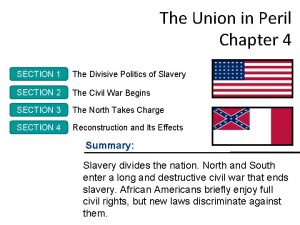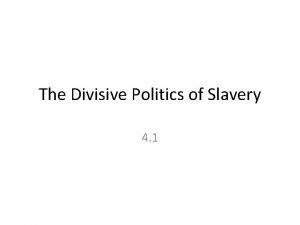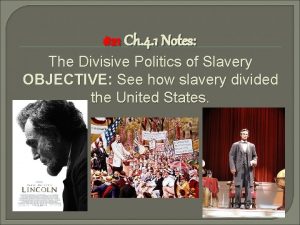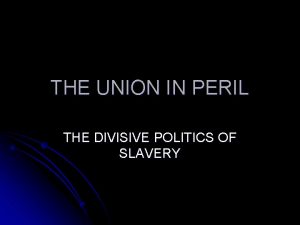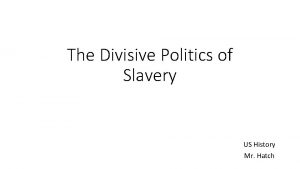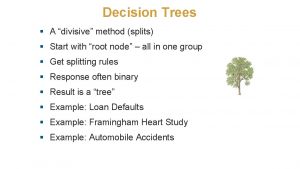29 Ch 4 1 Notes The Divisive Politics










- Slides: 10

#29 Ch. 4. 1 Notes: The Divisive Politics of Slavery OBJECTIVE: See how slavery divided the United States.

Ch. 4. 1 Key Terms secession- decision by a state to leave the Union. popular sovereignty- a system in which the residents vote to decide an issue. • Example: Issue of Slavery (Pro-Slavery vs. Non. Slavery)

Differences Between North and South • Issue of Slavery Intensifies. Leads to … The Compromise of 1850 (Henry Clay) 1. California would be a free state 2. Tougher fugitive slave law 3. A state vote would decide the slavery issue.

Protest, Resistance, and Violence Tougher fugitive slave law led to the… Underground Railroad. • System of routes in which runaway slaves were helped to escape into Canada or other safe areas. • Conductors hid runaway slaves and directed them to freedom. • Harriet Tubman: famous conductor. Helped 300+ slaves.

The Kansas-Nebraska Act of 1854 Split Nebraska into the territories of Kansas and Nebraska. • Question: Should slavery be legal in these states? • Did popular sovereignty solve the issue? No!!! It led to increased violence…. ”Bleeding Kansas”

New Political Parties Whig Party split into two: Northern Whigs and Southern Whigs. Know-Nothing Party also split into two. Free-Soil Party- Northerners who opposed slavery because they feared it would drive down wages of white workers. Republican Party forms in 1854; oppose slavery in territories.

Conflicts Leading to Secession Dred Scott decision: slave taken to free territory by owner, claims freedom. Supreme Court denies appeal; Scott has no legal rights, not a citizen. • Precedent: Being in a free territory did not make a slave free. Abraham Lincoln vs. Stephen Douglas Senate Debates: • • Douglas wants popular sovereignty to decide slavery Lincoln wants amendment to end

Conflicts Leading to Secession Harper’s Ferry: John Brown leads group to arsenal to start slave uprising. Troops put down rebellion; Brown is tried and executed. Lincoln Elected President: 1860, Lincoln wins election; receives zero southern electoral votes. Southern Secession: 7 states secede after Lincoln’s victory. Former Senator Jefferson Davis elected President of Confederacy.

1860 U. S. Electoral Map

#29 John Brown Bubble Maps Create 2 bubble maps (color code each map) to describe John Brown. SOUTH --- One from a Southerner’s point of view. --- One from a Northerner’s point of view. 1. What conclusions can be made based on the two bubble maps? 2. Why is this information important in understanding the conflict of slavery in America during this time period? NORTH
